How to Create and Maintain an Indoor Worm Composting Bin
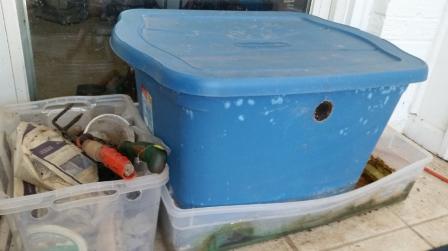 A worm composting bin, known as a vermicomposter, can be fairly inexpensive and easy to maintain. There are several ways to vermicompost. Below are instructions on how to build one kind of worm composting bin designed to be used inside. It is also possible to purchase worm composting bins. You will want to put your bin in an indoor space as you do not want the worms to freeze in the winter or get too warm in the summer. Additionally, you may want to put the bin in a basement or other out-of-the-way space since you will be producing compost and worm “tea” in the composter.
A worm composting bin, known as a vermicomposter, can be fairly inexpensive and easy to maintain. There are several ways to vermicompost. Below are instructions on how to build one kind of worm composting bin designed to be used inside. It is also possible to purchase worm composting bins. You will want to put your bin in an indoor space as you do not want the worms to freeze in the winter or get too warm in the summer. Additionally, you may want to put the bin in a basement or other out-of-the-way space since you will be producing compost and worm “tea” in the composter.
On this page:
- What You Need
- Preparing the Bins
- Preparing the Paper, Soil, Water Medium and Adding the Worms
- Feeding the Worms
- Maintaining the Bin
What You Need
First, buy, borrow or repurpose the following items that you will need to start worm composting:
1. Two plastic bins – one must be taller and rest inside the other, shorter bin.
- The shorter, bottom bin does not need a top. A bin made of rubber or plastic and that is approximately 15 inches deep, 25 inches wide and 5 inches high works great. The extra length allows you to scoop out the extra liquid or “worm tea” for use elsewhere (e.g., in the garden, for plants, shrubs, etc.).
- The top tub should have a top to keep the worms from finding their way outside the box. It also needs to be somewhat flexible so you can drill holes into it. An 18 gallon tub that is roughly 15 inches deep, 20 inches wide and 15 inches tall works well.
2. A drill – A drill with a one inch diameter and a one-eighth inch diameter drill bit is needed to drill the holes mentioned above.
3. Screening material – The type used for window screens is fine – just be sure NOT to use metal which will rust over time when exposed to the moisture in the bin. You only need about four 4 inch by 4 inch scraps of screen. Why use screening? If you don’t cover the holes, the worms may escape.
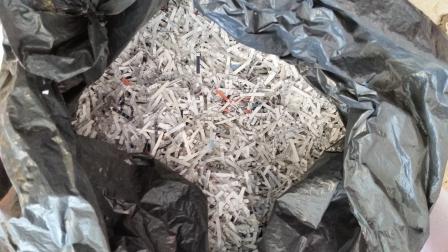 4. Waterproof glue – To keep the screens in place, even after they get wet.
4. Waterproof glue – To keep the screens in place, even after they get wet.
5. Shredded paper – Enough to fill your bin three inches deep and extra to add each time you feed the worms once a week. Almost any kind of paper works, but avoid heavy, shiny paper and colored paper.
6. A little bit of dirt – A pound will be enough. Just make sure it does not have harmful chemicals in it. If all goes well, the worms will be producing their own dirt (compost) soon.
7. A little bit of water – Some water is needed to moisten the paper and dirt to create a comfortable medium for the worms to thrive. Soak the paper and then drain it before using.
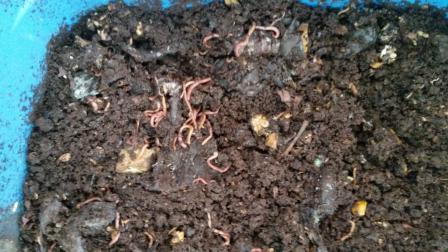 8. Worms – A pound of red wrigglers are recommended because they consume waste quickly, but earthworms also work. Red wrigglers are available online, from your U.S. Department of Agriculture (USDA) extension office or from another worm bin owner. Be careful of worms that are invasive species, such as the Asian Jumping Worm, which can be sold as the Alabama Jumper or Georgia Jumper. Worm bins produce more worms as well as great compost.
8. Worms – A pound of red wrigglers are recommended because they consume waste quickly, but earthworms also work. Red wrigglers are available online, from your U.S. Department of Agriculture (USDA) extension office or from another worm bin owner. Be careful of worms that are invasive species, such as the Asian Jumping Worm, which can be sold as the Alabama Jumper or Georgia Jumper. Worm bins produce more worms as well as great compost.
9. A trowel – Needed to move the compost as needed in the bin.
10. Food scraps container – Use a small container with a tightly fitting top to collect vegetable and fruit scraps.
Why not just put the food straight into the worm bin? Worms do best left alone, so it is best to feed them only once a week. Use the food scraps container to collect scraps for a week and then feed the worms weekly.
Preparing the Bins
Below are the steps to take to prepare the bins:
- Drill a 1-inch hole about two inches from the top of the taller bin on one side. Drill another hole on the opposite side. Drill four 1/8-inch holes near the bottom near the corners of the bin.
- Cover each of the holes with vinyl screening and glue the screening in place with the waterproof glue. Be sure the glue is completely dry before continuing to the next step.
- Place the tall bin inside the short bin. Do NOT drill any holes in the short bin.
Preparing the Paper, Soil, Water Medium and Adding the Worms
Combine shredded paper, soil and just enough water to dampen everything. Put the mixture into the tall bin and fill the bin about three inches deep. Add your worms to the mixture and let them get used to it for a day before feeding them. Make sure the mixture is very moist, but not forming puddles of water.
Feeding the Worms
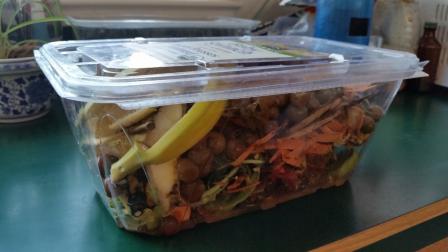 Collect food scraps, such as vegetables and fruit scraps, bread, tea bags, coffee grounds, and cereal in your food scrap container as you prepare and clean up after meals. Do not include any animal by-products (fat, bone, dairy, meat, waste). Also, it may take the worms longer to process woody or dry items like stems or the outer layer of onions. Worms will eat paper as long as it is thin or cut into small pieces, but they will not eat plastic or fabric tea bags, coffee filters or the labels placed on produce by grocery stores. Learn more about what to and what not to feed your worms. Exit
Collect food scraps, such as vegetables and fruit scraps, bread, tea bags, coffee grounds, and cereal in your food scrap container as you prepare and clean up after meals. Do not include any animal by-products (fat, bone, dairy, meat, waste). Also, it may take the worms longer to process woody or dry items like stems or the outer layer of onions. Worms will eat paper as long as it is thin or cut into small pieces, but they will not eat plastic or fabric tea bags, coffee filters or the labels placed on produce by grocery stores. Learn more about what to and what not to feed your worms. Exit
Once a week, do the following:
- Take the scraps to the worm bin.
- Gently use a trowel to create a hole to put the scraps into.
- Throw in a small handful of shredded paper.
- Add all the food scraps on top of the paper.
- Cover ALL of the food scraps with dirt and moist paper. Exposed food attracts fruit flies, but covered food scraps don’t. Add dirt and moist paper to the bin until the worms have made enough compost to use to cover the food scraps.
- Notice what the worms are eating and what they are not. Remove any scraps that your worms have not eaten for a while as they may not like that type of food (e.g., some worms will not tackle a whole potato or citrus rind, but may eat them if they are cut up).
- Put the lid back on the worm bin.
- Wash out the food scraps container for the coming week.
Maintaining the Bin
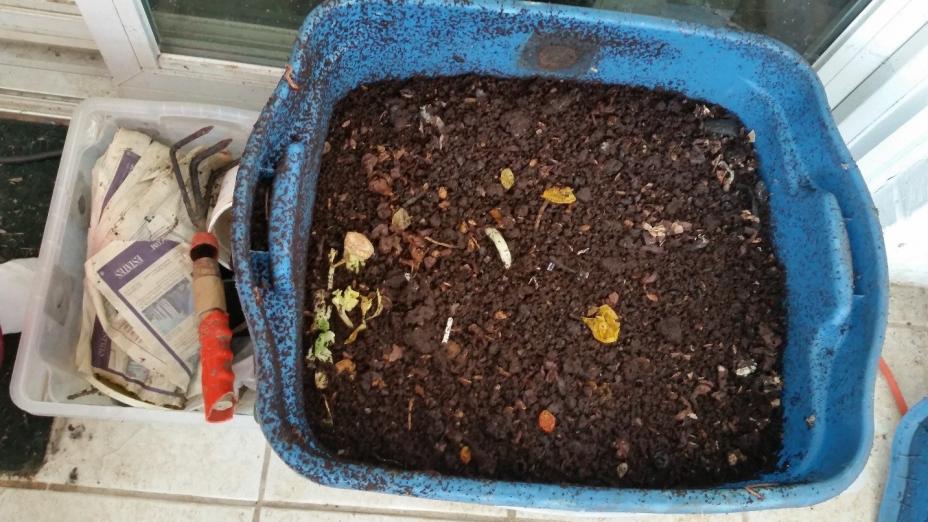 Once every few months, scoop the liquid out of the lower container and use it as fertilizer outside on soil near plants, or water it down to use on indoor plants. When the worm bin is full (i.e., when the compost reaches the bottom of the top holes you drilled), do the following:
Once every few months, scoop the liquid out of the lower container and use it as fertilizer outside on soil near plants, or water it down to use on indoor plants. When the worm bin is full (i.e., when the compost reaches the bottom of the top holes you drilled), do the following:
- Feed the worms on one side of the bin for a couple of weeks in order to draw the worms to that side.
- Once all the worms are on one side, harvest the compost on the other side and use it in pots, your garden, or sprinkle it across your yard. You can also scoop compost and worms onto a newspaper and sort them out, but this is a bit messier. Be sure to harvest compost at the end of the week, before you feed the worms again.
- If there are too many worms in the worm bin, share extras with friends and family or release some with the dirt in your yard.
